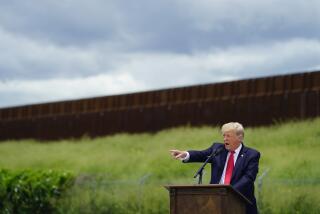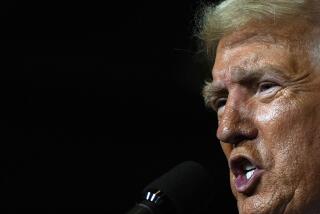Editorial: Trump’s new immigration freeze is just more of his tired political posturing
You have to say one thing for President Trump: He has yet to find a crisis he can’t try to exploit for his own political gain. Trump tweeted late Monday that he intends to sign an executive order halting all immigration to the U.S. (never mind that closed government offices have already effectively made it impossible to immigrate legally); reports out of the White House Tuesday said he intended to freeze new green cards for relatives of existing green card holders and for people expecting to move here to take a job offer. Notably, he didn’t attribute the decision to fears that new arrivals could exacerbate the spread of the coronavirus, but because they would compete with U.S. workers for jobs, which have been disappearing at a stunning rate in recent weeks.
Trump won election in part through bashing immigration, both legal and illegal, and has worked diligently since then to limit new arrivals while ramping up arrests of people here without permission. He has sharply lowered the cap on the number of refugees accepted for resettlement, while also trying to restrict asylum claims by denying them from people who did not present themselves at a legal port of entry.
That policy went into effect despite an immigration law that states plainly that any foreign national “who is physically present in the United States or who arrives in the United States (whether or not at a designated port of arrival…)” is eligible to apply. The administration also has forced those applying at ports of entry to remain in Mexico while the lengthy process plays out. But as the pandemic grew, the president shut down nearly all non-trade traffic at the southern and northern borders — including asylum seekers.
Now, citing the massive job losses from widespread stay at home orders, Trump intends to halt all immigration. “In light of the attack from the Invisible Enemy, as well as the need to protect the jobs of our GREAT American Citizens, I will be signing an Executive Order to temporarily suspend immigration into the United States!” the president tweeted.
Press Secretary Kayleigh McEnany followed that up with a statement Tuesday morning that “President Trump is committed to protecting the health and economic well-being of American citizens as we face unprecedented times. As President Trump has said, ‘Decades of record immigration have produced lower wages and higher unemployment for our citizens, especially for African-American and Latino workers.’ At a time when Americans are looking to get back to work, action is necessary.”
But the president’s assertions just aren’t true. Numerous studies have found that new arrivals tend to take jobs that employers have trouble filling — often tasks that pay poorly, are dangerous and involve hard physical labor. Those workers tend to compete with and dampen wages for the immigrants who preceded them into the country.
But the new arrivals also add to the economy and help create higher-paying, less physically strenuous jobs for native-born workers. As the Brookings Institute reported in 2012, “immigrants and U.S.-born workers generally do not compete for the same jobs,” and “low-skilled immigrant laborers allow U.S.-born farmers, contractors, and craftsmen to expand agricultural production or to build more homes — thereby expanding employment possibilities and incomes for U.S. workers.” And they also help support local retail shops, restaurants and other businesses. The economic impact of immigrant workers tilts heavily to the positive end of the scale.
Does that change during an economic crisis like this? In some ways, yes. Is it reasonable to declare a short-term hiatus? Perhaps. But that has already been put into effect by the shuttering of government offices that process visa applications, by the restrictions on travel, and by the collapse of the labor market (economic migrants tend not to travel for jobs that don’t exist).
It’s hard to assess whether the president’s metaphorical barricading of the border will help or damage the economy until we see what, exactly, he will do. But bear in mind that the current disruption of the economy is not permanent, and that the president himself has argued vociferously for a (too rapid) lifting of the restraints on commerce. No one can offer a reliable sense of what the future economy will look like, but it will need workers, whether they are new-arriving immigrants or laid-off native-born Americans.
It’s no coincidence that his call for a ban on new immigrants dovetails with one of his signature campaign issues at a time when the vibrant economy he had planned to campaign on has cratered. This is about saving one job — the president’s.
More to Read
Updates
1:09 p.m. April 21, 2020: This editorial was updated with more details about the president’s planned actions on immigration.
A cure for the common opinion
Get thought-provoking perspectives with our weekly newsletter.
You may occasionally receive promotional content from the Los Angeles Times.










